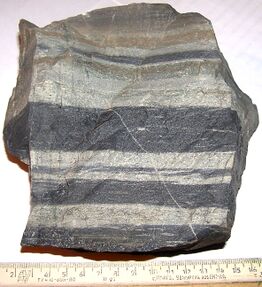Hornfels
Hornfels is a metamorphic type of rock and originates from a parent rock that is exposed to very high temperatures varying from about 700 to 800 degrees Celsius. This type of metamorphic rock has its origin in a shallower depth relative to other metamorphic rocks. It is formed by nearby magma chambers, sills, dikes or lava flows.
Hornfels
This type of rock is difficult to characterize because it takes over the character of its parent rock and does not have a specific chemical or mineralogical composition. Moreover one can't say anything over the orientation of the grains, because this rock wasn't exposed to directed pressure and also took over its preferred orientation from its parent rock.
Origin
Hornfels form from a parent rock or a so called protoliths. These protoliths can be many type of rocks. Common protoliths of hornfels include sedimentary rocks such as shale, siltstone, sandstone, limestone and dolomite; igneous rocks such as basalt, gabbro, rhyolite, granite, andesite and diabase; or, metamorphic rocks such as schist and gneiss.
Characteristics
As mentioned before it is very hard to characterize hornfels. They even can be made by a various of effects including recrystallization, partial melting, cementation and silicification. This results in a dense, hard, fine-grained rock that is generally homogenous and exhibits a semi-conchoidal fracture. Hornfels can be almost any color, but black, gray, brown, reddish and greenish rocks are common. On the basis of mineral composition, most occurrences of hornfels can be separated into one of three general groups:
- Pelitic Hornfels: usually derived from shale, slate, and schist
- Carbonate Hornfels: usually derived from limestone, dolomite or marble
- Mafic Hornfels: usually derived from mafic igneous rocks [1]
References
- https://geology.com/
- NEN-EN-ISO 14688-1:2019
Hornfels

| Type | Metamorphic rock |
|---|---|
| Texture | Banded |
| Clasts | Very fine |
| Hardness | Very hard |
| Color | Depends on parent rock |
| Minerals | Depends on parent rock |
| Touch | Smooth |
| Image | Hornfels |